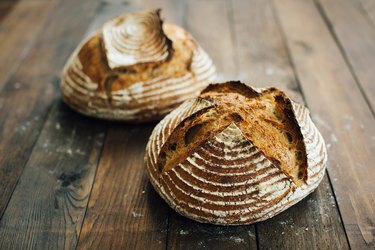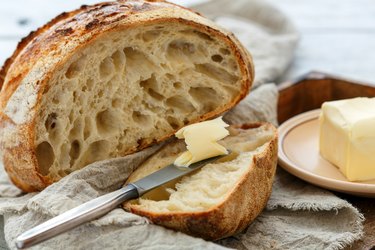
Flour, water and salt — that's all it takes to make a loaf of sourdough bread. So if you have these ingredients on hand (and some free time) you can actually make your own bread at home.
While pulling a loaf off the supermarket shelf takes minimal effort, there are benefits to making your own bread at home — especially when it comes to sourdough.
Video of the Day
Video of the Day
First, baking can help relieve stress and stress-baking a loaf of bread will probably serve you better nutritionally than a pan of brownies. It's also fun, inexpensive and can be healthier than typical store-bought breads. Plus, it just tastes good, especially warm out of the oven.
What Is Sourdough, Exactly?
Sourdough bread lives up to its name. The "sour" flavor comes from the fermentation process and the lactic acid bacteria that occurs naturally in the flour.
To make sourdough, you usually begin with a "starter" by either making your own at home or being gifted one from a friend or family member. A starter is really just flour and water that has been allowed to ferment (when the natural bacteria in the grains grow) over the course of a few days — in some cases it can take up to 10, according to the Sourdough School.
The sourdough fermentation process is more effective at reducing the phytic acid level than the typical bread-making process, which adds yeast to leaven the bread.
The Health Benefits of Sourdough Bread
Sourdough isn't just a delicious white bread — it has some unique health benefits, too.
1. You'll Get Better Nutrient Absorption
Phytic acid occurs naturally in plant foods such as beans, seeds and whole grains. Some groups give it a bad rap as an "anti-nutrient" because it limits the absorption of certain minerals including iron and zinc. Soaking, cooking and fermenting can all reduce the phytic acid in these food.
This is where sourdough comes in. Part of the sourdough fermentation process reduces phytic acid, which helps increase the availability of specific minerals like magnesium and phosphorus, according to an older May 2001 paper published in the Journal of Agriculture and Food Chemistry. In this study, phytic acid was reduced by 62 percent in whole-grain sourdough bread compared to 38 percent in regular whole-grain bread.
2. It's Easier to Digest Because of Its Low Gluten and FODMAP Content
Compared to other breads, sourdough has less gluten, which makes it a potential option for those with gluten sensitivities or intolerances.
It's not gluten-free, but research shows the longer fermentation process (compared to traditional bread) helps the starches and proteins in the bread to be broken down further. The probiotics and fermentation process was shown to considerably reduce the gluten content in sourdough in this older May 2007 study published in Applied and Environmental Biology.
Sourdough is also lower in FODMAPs, an acronym that stands for a group of fermentable carbohydrates that can cause GI issues, especially in those with irritable bowel syndrome (IBS). Similar to how the gluten is broken down in the fermentation process by the yeast and bacteria, the carbohydrates (including the FODMAPs) are also broken down, which reduces the overall content, according to Monash University.
3. It's a Source of Prebiotics
Because sourdough undergoes a fermentation process, there's a misconception that it's a source of probiotics. Unfortunately, any beneficial bacteria present in the dough is killed off during the baking process.
The good news is sourdough is a source of prebiotics, which are responsible for helping feed the probiotics in our gut, as explained in a June 2013 paper published in Applied and Environmental Biology.
4. It May Be Better for Blood Sugar Control
The leavening process of sourdough bread compared to traditional bread may help improve how the carbohydrates in your loaf are digested, according to a May 2009 study in the Journal of Cereal Science.
The study found that compared to regular bread (both wheat and white), sourdough bread had a significantly lower glycemic response compared to regular bread. There is more resistant starch in sourdough (compared to traditional bread), which helps blunt spikes in blood sugar. It also has a lower glycemic index.
While sourdough has a lower glycemic index, newer research shows the effect this has on blood sugar can vary from person to person. Some people experienced a higher spike in blood sugar after eating sourdough bread and others saw a greater spike after eating white bread, researchers in a June 2017 study published in Cell Metabolism found.
How Sourdough Stacks Up to White Bread
There are many differences between sourdough bread and traditional bread aside from reduced phytic acid, prebiotics, and lower amounts of FODMAPs and gluten. Here's how the two stack up nutritionally.
Sourdough Bread | White Bread | |
Calories | 130 | 130 |
Total carbohydrates | 25 g | 25 g |
Fiber | 1 g | 1 g |
Protein | 5 g | 4 g |
Folate | 15% DV | 3% DV |
Iron | 8% DV | 3% DV |
A Sourdough Bread Recipe to Try at Home

For this recipe, we'll assume you're making your own starter.
How to Make Sourdough Starter
Ingredients:
- Whole-wheat flour
- All-purpose flour
- Water
Instructions:
- Add flour and water in a glass or glass or ceramic container (1-quart in size or bigger) and combine until there are no dry clumps. Cover loosely and leave at room temperature for 24 hours.
- The next day, remove half of the flour-water starter mixture. Add 1 cup of all-purpose flour and 1/2 cup lukewarm water (if your house is cool) or cool water (if your house is warm). Mix well, cover loosely again and let sit for another 24 hours.
- On day 3, you should definitely start to see some bubbling happening in the container and the starter should be gaining in size. Remove about 4 ounces of starter mixture (discard the rest), add the 1 cup of all-purpose flour and 1/2 cup water, mix well and cover. Let sit for 12 hours this time and then repeat. The goal is to do this twice in one day.
- Repeat what you did in step #3.
- On day 5, repeat step #3. You're looking for a starter that smells tangy, has almost doubled in size and has many little bubbles. If your starter hasn't reached this point yet, continue to repeat step #3.
- If your starter is ready, give it one more feeding by keeping 4 ounces (discarding the rest) and adding a cup of flour and a 1/2 cup of water. This time, only let it sit for 8 hours before using.
How to Make Sourdough Bread
Ingredients:
- 2 cups sourdough starter (stir-down starter if measuring out the volume, or use 454 grams)
- 5 cups all-purpose flour
- 3/4 cup whole-wheat flour
- 1 3/4 cup water
- 2 teaspoons salt
Instructions:
- Combine starter, all-purpose flour, whole-wheat flour and water in a large bowl until well mixed.
- Cover with a towel and let sit for 25 minutes.
- Add salt and knead the dough until it's smooth yet still tacky. Put back into the bowl and cover with a towel for 1 hour.
- Put the dough on a floured surface and fold the dough by flattening it a bit and folding it, repeat and fold again. Put back into the bowl.
- Divide the dough in half, shape into rounds with a floured cloth and place in a bowl. Let sit for 2 1/2 hours.
- Preheat oven to 450 degrees, line baking sheet with parchment paper and place the two loaves on the pan.
- Bake for 30 to 40 minutes until golden.
- The Sourdough School: "How to Get a Sourdough Starter Going From Scratch"
- Journal of Agriculture and Food Chemistry: "Prolonged Fermentation of Whole Wheat Sourdough Reduces Phytate Level and Increases Soluble Magnesium"
- Applied and Environmental Biology: "Highly Efficient Gluten Degradation by Lactobacilli and Fungal Proteases during Food Processing: New Perspectives for Celiac Disease"
- Monash University: "Sourdough Processing & FODMAPs"
- APrebiotic Content of Bread Prepared with Flour from Immature Wheat Grain and Selected Dextran-Producing Lactic Acid Bacteria"pplied and Environmental Biology: "
- Journal of Cereal Science: "Sourdough Bread: Starch Digestibility and Postprandial Glycemic Response"
- Cell Metabolism: "Bread Affects Clinical Parameters and Induces Gut Microbiome-Associated Personal Glycemic Responses"
- FoodData Central: "Sourdough"
- FoodData Central: "French Bread"